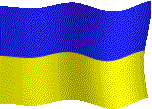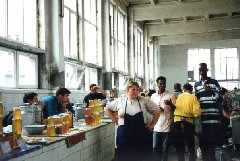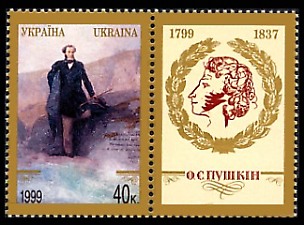


UKRAINE UKRAINA |
7 SEPTEMBER
ODESSA
Tales of A Lost Past
JOURNEY TO ODESSA The morning light shone on my face and I realized that the train would soon reach Odessa. By then, the train had travelled across the northwestern shore of the Black Sea, passing the city of Kherson, near the site of another great ancient Greek city, Olbia. Like its counterparts in Crimea, the city had become rich from the trade between inland nomads and the Mediterranean World. Ascherson wrote about Greek philosopher, Dio Chrysostom’s visit to Olbia in 95 AD. By then, the city had been sacked by barbarian tribes, traders had stopped coming, and economic decline had set in. The city’s citizens now wore Scythian dress, although they were still proud of their hopelessly diluting Greek heritage. They spoke Greek, though not the most fashionable form heard in Athens, but an archaic dialect discarded in Greece a long time ago, interspersed with Scthian words and patois. The relative isolation of the Olbian Greeks had meant the virtual standstill of its Greek language, untouched by developments elsewhere. This phenomena was no different from the archaic Portuguese spoken among a smallish Malay-Portuguese community in Melaka, Malaysia, and the Old German spoken in the once-flourishing Saxon community in Transylvania. Market: Why are you taking my photo ?
Market: Why are you taking my photo ?
In addition, the Olbians tried to behave like good Greeks as well, wearing false beards and covering their arms – customs long abandoned in Greece proper, but remained in vogue in Olbia. What was Dio’s most fascinating discovery, however, was that the ancient Greek veneration of homosexual love as the supreme intellectual and spiritual experience – also no longer popular in the Hellenic Lands - was still very much alive and fashionable in Olbia. In fact, a gallant young warrior and prominent citizen of Olbia Dio met was also renowned to have “many male lovers”. Given the Olbian desire to announce its Greekness, this fact was treated more as an evidence of the warrior’s achievements rather than merely his orientation.
Near here the Dnieper enters the Black Sea. The Mother River of Ukraine, which flows through Kyiv, and the Coassack heartland of Ukraine. It was also around here where the Norwegian Viking King, Harald Hardraada, sailed through on his return to Norway from his adventures as chief of the Byzantine Emperor’s elite Guards. Refused permission to leave Constantinople, he blinded the Emperor, kidnapped a princess, and rammed through the gates of Bosphorus, sailed across the Black Sea, up the Dnieper, married the princess of Kyiv, and returned to Norway where he won the battle for kingship. Greedier still, he invaded England only to be slaughtered by King Harold II at the Battle of Stamford Bridge, a few weeks before the latter was himself vanquished at the Battle of Hastings in 1066.City of Grandeur, Exiles and Love
ODESSA The train arrived in Odessa at about 06:50. The moment I stepped out of the train, I was amazed by the Baroque grandeur of the Train Station - its neo-classical columns and statues, as well as glass chandeliers and more – these reminded me of Vienna and Paris than an industrial seaport of Ukraine.
Odessa was founded by the Russians 200 years ago upon the conquest of the region from the Turks. Mistakably named after the Greek city of Odessos (which was later found much further away in what is today Bulgaria), Odessa quickly became the most important port of the Russian Empire. Its wealth, glorious past and cosmopolitan nature are reflected in the grand 19th century and early 20th century architecture. It boosts many fine buildings, leafy streets, statues and public sculptures by European masters, and a magnificent opera house equal to Viennese standards.
I checked into Chome More Hotel, a 1970’s Intourist-type den. To my surprise, the staff of Hotel Chome More, or Hotel Black Sea as it is known in Russian, were reasonably friendly. The room rates were also reasonable, although the internet access rates were ridiculous at US$10/hour. I would visit cybercafes later where they charged only US$2/hour. After a quick bath, I started exploring the city.Walking around Odessa was a pleasant experience. Lots of grand old buildings and public sculptures. Leafy avenues shelter the stroller from the summer sun. Two peasant women selling warm donuts while a late arisen street hawker was busy setting up his newspaper booth – his regular customers were already buying from a rival a block down the street. A beggar had begun his day too, and had already secured a few coins. The elderly hobbling along with their walking sticks. Children walking to schools with their kiddie bags. The office worker smelling each other’s breath in the crowded city trams. This is bustling Odessa beginning its day.
Odessa is also the most cosmopolitan city this side of the Black Sea. Ships from the world over call at its port. Sailors of all skin colours walk on its streets. In fact, since its early days of foundation, people from not only the Russian Empire but also from abroad have settled here and helped built the city. This was a city with a French noblemen, Duc de Richelieu, as its first governor; Greek shipowners; Jewish and Armenian merchants; Nogay Tatar wine growers; Russian and Ukrainian peasants; Moldovan and Swiss colonists; Polish landlords; Entrepreneurs from Britain, Belgium and Denmark. Russian has always been the linqua franca, and laissez faire the spirit. In time, Odessa began to attract the persecuted and the exiled. The misery of life in the inland Pale attracted so many Jews to Odessa that by 1897, Yiddish was spoken by 32% of the population.
Political subverts and exiles were also attracted to the city. Alexander Pushkin, punished for breaking the Tsar’s orders, was exiled here. It was in 1823 at a small apartment at Primorskie where he wrote his greatest work, Eugene Onegin, an epic poem which depicted a complicated love affair and resulting duel, the latter of which occurred in circumstances so fatally similar to the one that eventually took his life. It was also in Odessa where he carried on a widely known scandalous affair with the wife of Count Vorontsov, Governor of Novorossiya of which Odessa was capital. Within a year, the Count could no longer stand being a cuckold and had him expelled from the city. According to Ascherson, Pushkin left Odessa with a gold Hebrew ring, which was slipped onto his finger by the Countess, while they were making love on an Odessa beach. It was said that the ring stayed on his finger ever since and was only removed upon his death. Ukrainian stamps commemorating the birth of Alexander Pushkin
Ukrainian stamps commemorating the birth of Alexander Pushkin
Russia’s national poet lived and fell in love here. The same goes for Poland’s Adam Mickiewicz – he came here in exile in 1825, not long after Pushkin’s departure. Away from his beloved conservative Catholic homeland, Mickiewicz lived a carefree Bohemian life. He became a patron of whore houses and carried on passionate love affairs with a succession of four Polish ladies, one of which was a well known socialite and a Tsarist spy.
20th century Odessa is famous for its comedians. Some of the greatest Soviet era comedians were from Odessa. Odessans are known to laugh at anything and anyone – including the Jews – i.e., themselves as many Odessans are Jewish - and Eskimo-Chukchis – who doesn’t – there are so few of them around. Concerned about being politically incorrect ? Odessans don’t give a damn ! Odessans travelling around are often asked: “What news from Derybasivska ?” meaning what are the latest jokes from Odessa’s main thoroughfare. And of course, he or she is obliged to have a bag of jokes ready to meet such humorous expectations.I walked along the leafy Primorskie Bulvar, wondering which was Pushkin’s
apartment and tried imagining where he had his tryst with Madame Vorontsov.
In the middle of the street are the 193 Potemkin Steps, where the famous
battle scene of Battleship Potemkin, a Soviet Revolutionary movie about
the ship’s rebellion during the 1905 uprising, was filmed. The Duc
de Richelieu’s statue stood at the head of the Steps, with a cannon ball
– which ironically was lobbed there by the French Navy, who were bombarding
the city during the Crimean War. At the statue’s pedestal were carvings
of the goddess of Justice and Mercury. Lady Justice, unlike those
elsewhere, wasn’t depicted blindfolded here. According to local residents,
this is simply a reflection of the state of justice in today’s Ukraine.
In the evening, I met up with Tanya, an Odessan lady who runs a travel
agency. Got to know her on the internet, and it was a most interesting
evening with her partner and son, getting to know life in Odessa and the
ironies of life in the newly independent state of Ukraine. We had
quite a few drinks and great laughs. It’s amazing how the internet
have brought the world closer than ever before, and how friendships were
struck on that tiny little screen.
| RETURN TO FROM THE BALTIC TO THE BLACK SEA HOMEPAGE |